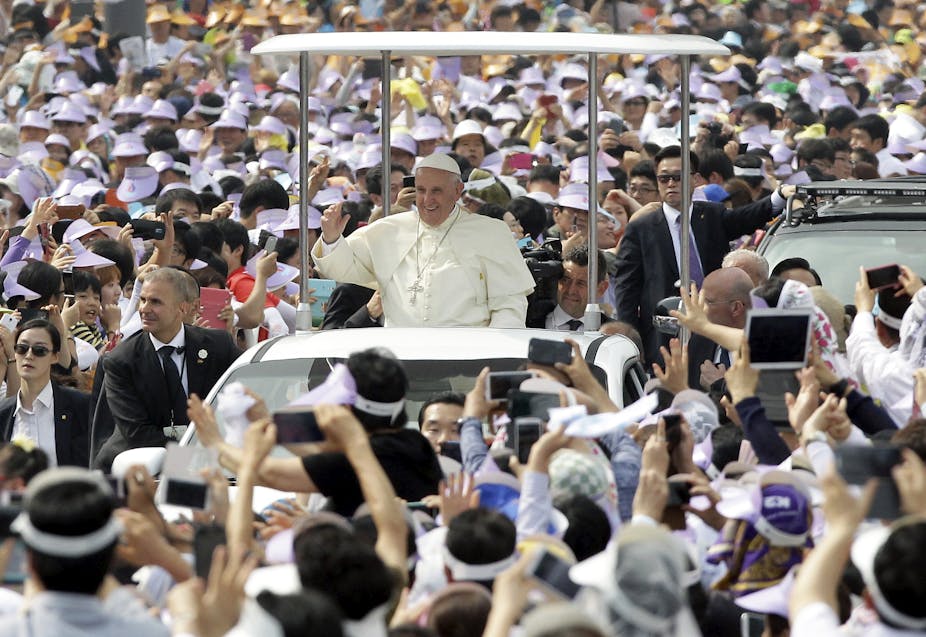Pope Francis flew over China on his way to South Korea late last week, where the Catholic Church has seen rapid growth in the last decade. Papal custom is to send a telegram to the leaders of nations over whose airspace he passes—thus when he flew over China, he sent the following message to President Xi Jinping:
Upon entering Chinese air space, I extend best wishes to your excellency and your fellow citizens, and I invoke the divine blessings of peace and well-being upon the nation.
There was no public response from President Xi, but this was not the first time that Pope Francis had contacted him. Earlier this year, he told an Italian newspaper, the Corriere della Sera, that they had already exchanged letters.
While the telegram was similar to those sent to other leaders, in the Chinese case, what was important was where it came from. This was the first time a pope had flown over the People’s Republic of China (PRC) since its establishment in 1949. When Pope John Paul II visited Seoul 40 years later, he was denied permission to travel over Chinese airspace and took a detour over Russia instead.
Change in the air?
Discussion has now turned to whether these recent contacts indicate a change in Sino-Vatican relations. If this is the case, it will be a complex path forward, fraught with long-standing disagreements. For many Chinese intellectuals of the early 20th century, Western missionary activity in China was a form of cultural imperialism.
During the Maoist period, it was emphasised that religion was the “opium” of the people. Not only was it a tool of oppression wielded by ruling classes – it was a false consciousness that hindered socialist construction.
Foreign missionaries were expelled from China after the Communists came to power. The Vatican’s representative in Beijing – Archbishop Antonio Riberi – remained in the country until 1951, but ordered Chinese Catholics to not participate in Communist activities. Beijing subsequently exiled him and since then the Vatican has maintained a diplomatic presence in Taipei, but not in the People’s Republic. Their recognition of the Republic of China (on Taiwan) continues to be a sticking-point in any discussions about Sino-Vatican relations.
Another issue is the naming of bishops. In the 1950s, China established the Protestant “Three-Self Patriotic Church” (standing for self-governance, self-support and self-propagation), and the “Catholic Patriotic Association”. While the naming of bishops requires authority from the Vatican, in China, it is the association that does this. These measures were, in part, meant to ensure that Chinese Christianity remained free of foreign interference and developed in alignment with China’s new socialist path.
After the Cultural Revolution – when numerous religious professionals were imprisoned as counter-revolutionaries – Deng Xiaoping ushered in a new era of tolerance. Religious practice was again permitted within the context of China’s official organisations, as long as it was law-abiding, patriotic and did not conflict with the Party’s aims.
But many Chinese Christians continue to worship outside of the official framework, while underground Catholic and Protestant churches and networks continue to expand. In 1978, the Vatican also granted permission for Chinese bishops to independently conduct church affairs; this includes ordaining other bishops. The gap between the Vatican-approved church, and the Catholic Patriotic Association, has therefore become blurred.
Long way up from here
There have been numerous disagreements in more recent years, too. The party issued a strong response when Pope John Paul II canonised 120 Chinese Catholics, most of whom had had died during the anti-foreign (and anti-Christian) Boxer Rebellion in 1900.
The party is also acutely aware of the Church’s role in the Polish anti-communist movement during the Cold War. And priests working outside of the Catholic Patriotic Association continue to face arrest. For example, the bishop Thaddeus Ma Daqin was arrested in 2012 for renouncing the association in front of party cadres. He remains under house arrest.
Pope Francis’ flight over Chinese airspace does suggest another space may have opened up on the ground—for Sino-Vatican relations to improve. And while the Pope’s attention on his trip has been focused on the Korean peninsula, China is hard to ignore.
At a meeting of Asian bishops on Sunday, Pope Francis spoke about his hope for “fraternal” dialogue with countries in the region with which the Vatican does not presently have relations, specifically seeking to allay fears about cultural imperialism. The PRC cannot have been far from his mind.
For now, it remains to be seen what will emerge from the Pope’s messages. After all, Pope John Paul II also wrote to Chinese leaders in the 1980s, and differences remain. Indeed, the State Administration for Religious Affairs has recently renewed its efforts to create a “Chinese Christian theology”. But the global Catholic community rivals China in size, and the two sides cannot ignore each other.
After Pope Francis left Seoul, he sent another message – similar to his first – to President Xi as he again flew over China. Regardless of how events unfold, one thing is certain: the Church has sought engagement with China since the 13th century and it is not about to give up anytime soon.

